Effect mechanism of diamond content on tribo-chemical processing of sapphire wafers using developed clusters of diamond and ceria chemically agglomerated abrasive cluster
IF 5.6
2区 材料科学
Q1 MATERIALS SCIENCE, CERAMICS
引用次数: 0
Abstract
To enhance the material removal rate (MRR) and surface quality of sapphire wafers during lapping, this study proposes a new method for preparing chemically agglomerated abrasive clusters (CAAC). Using this method, five distinct CAAC abrasives, each with a different diamond content, were prepared for lapping experiments on sapphire wafers. MRR and surface roughness Ra were used as evaluation indicators to elucidate the removal behavior of CAAC abrasive particles during the lapping of sapphire wafers. The study analyzed changes in the friction curve, the elemental composition of the sapphire surface before and after lapping, and the microscopic morphology of the CAAC abrasives. The results indicate that #4 CAAC demonstrates the highest MRR and favorable surface quality among the tested variants. Specifically, #4 CAAC achieved the highest removal rate of 380.267 nm/min and the lowest surface roughness of 33.978 nm, outperforming #1, #2, #3, and #5 CAAC. Compared to W50 single crystalline diamond (W50 SCD) of equivalent grain size, the MRR increased by a factor of 3.1. Furthermore, within a certain range, the machining performance of CAAC improves with an increase in diamond content; however, both excessively high and low diamond contents negatively impact overall performance. When the diamond content in CAAC reaches 42 %, machinability is optimized. This method enhances the processing efficiency of sapphire wafers, improves surface quality, and offers innovative approaches for efficient and cost-effective sapphire wafer processing.
金刚石含量对发育金刚石团簇和氧化铈化学凝聚磨料团簇的蓝宝石晶圆摩擦化学加工的影响机理
为了提高蓝宝石晶圆研磨过程中的材料去除率和表面质量,提出了一种制备化学团聚磨料团簇(CAAC)的新方法。利用这种方法,制备了五种不同的CAAC磨料,每种磨料含有不同的钻石含量,用于蓝宝石晶圆的研磨实验。以MRR和表面粗糙度Ra作为评价指标,研究了蓝宝石晶圆研磨过程中CAAC磨粒的去除行为。研究分析了研磨前后蓝宝石表面的摩擦曲线变化、元素组成以及CAAC磨料的微观形貌。结果表明,4号CAAC的MRR最高,表面质量较好。其中,#4的去除率最高,为380.267 nm/min,表面粗糙度最低,为33.978 nm,优于#1、#2、#3和#5。与同等晶粒尺寸的W50单晶金刚石(W50 SCD)相比,MRR提高了3.1倍。在一定范围内,CAAC的加工性能随金刚石含量的增加而改善;然而,过高或过低的钻石含量都会对整体性能产生负面影响。当CAAC中金刚石含量达到42%时,可加工性得到优化。该方法提高了蓝宝石晶圆的加工效率,改善了表面质量,为高效、低成本的蓝宝石晶圆加工提供了创新途径。
本文章由计算机程序翻译,如有差异,请以英文原文为准。
求助全文
约1分钟内获得全文
求助全文
来源期刊

Ceramics International
工程技术-材料科学:硅酸盐
CiteScore
9.40
自引率
15.40%
发文量
4558
审稿时长
25 days
期刊介绍:
Ceramics International covers the science of advanced ceramic materials. The journal encourages contributions that demonstrate how an understanding of the basic chemical and physical phenomena may direct materials design and stimulate ideas for new or improved processing techniques, in order to obtain materials with desired structural features and properties.
Ceramics International covers oxide and non-oxide ceramics, functional glasses, glass ceramics, amorphous inorganic non-metallic materials (and their combinations with metal and organic materials), in the form of particulates, dense or porous bodies, thin/thick films and laminated, graded and composite structures. Process related topics such as ceramic-ceramic joints or joining ceramics with dissimilar materials, as well as surface finishing and conditioning are also covered. Besides traditional processing techniques, manufacturing routes of interest include innovative procedures benefiting from externally applied stresses, electromagnetic fields and energetic beams, as well as top-down and self-assembly nanotechnology approaches. In addition, the journal welcomes submissions on bio-inspired and bio-enabled materials designs, experimentally validated multi scale modelling and simulation for materials design, and the use of the most advanced chemical and physical characterization techniques of structure, properties and behaviour.
Technologically relevant low-dimensional systems are a particular focus of Ceramics International. These include 0, 1 and 2-D nanomaterials (also covering CNTs, graphene and related materials, and diamond-like carbons), their nanocomposites, as well as nano-hybrids and hierarchical multifunctional nanostructures that might integrate molecular, biological and electronic components.
 求助内容:
求助内容: 应助结果提醒方式:
应助结果提醒方式:


